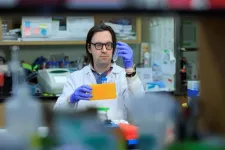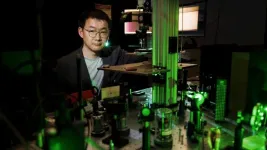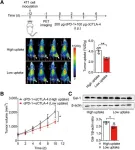(Press-News.org) Lithium-Ion batteries presently are the ubiquitous source of electrical energy in mobile devices, and the key technology for e-mobility and energy storage. Massive interdisciplinary research efforts are underway both to develop practical alternatives that are more sustainable and environmentally friendly, and to develop batteries that are safer, more performing, and longer-lasting – particularly for applications demanding high capacity and very dense energy storage. Understanding degradations and failure mechanisms in detail opens opportunities to better predict and mitigate them.
In the study, a team of researchers led by the CEA, the ILL and the ESRF in collaboration examined Li-ion batteries during their lifetime using state-of-the-art, non-intrusive imaging techniques available at neutron and X-ray sources, respectively the Institut Laue Langevin (ILL), the world’s most powerful neutron source, and the European Synchrotron (ESRF), the brightest synchrotron. Neutrons and photons are largely complementary. Neutrons are particularly good at seeing lithium and other light elements, while X-rays are sensitive to heavy elements, such as nickel and copper. Their sophisticated combination allowed to gain multidimensional information on the components and elements inside working battery cells.
The team identified macroscopic deformations in the wound structure of the copper current collector. The deformed areas already existed in fresh battery cells that only went through the initial activation cycle (the first charging-discharging cycle). Further investigations revealed that these defects are due to local accumulations of silicon occurring during electrode manufacturing. Upon activation, the largest agglomerates expand heavily, which leads to deformations in the current collector, wasting capacity before the cell ever went into use.
It was possible to determine how large these accumulations have to be to become a problem: cell structure and functioning is compromised for silicon agglomerations with a size above 50 microns. This is crucial information for both quality control and future developments. Erik Lübke, PhD student hosted at ILL and the main author of the study, summarises: “In fact, resources are wasted when this happens, and we have quantified the effects and understood their causes."
Full-field, high-resolution 3D transmission tomography enabled the inspection of the entire volume of the battery cell, revealing the presence of a number of defect features. These were more closely investigated at selected cross-sectional 2D slices. The neutron tomography scans (with simultaneous low intensity X-ray computed tomography scans) were carried out at the NeXT instrument of the ILL. Synchrotron X-ray tomography scans of the very same cells were then measured at the ESRF using two beamlines, BM05 and the high-energy ID31 beamline for phase-contrast and scattering tomography respectively.
At NeXT, 3D high resolution neutron tomography is coupled with X-ray tomography to image the entire cell. Erik Lübke explains that “X-rays give the basic structure, making it possible to know exactly where we are when we use neutrons to examine the spatial distribution of lithium in detail” benefiting from “the best neutron resolution you can get anywhere in the world”.
Selected parts of the cell were then examined in further detail using several different X-ray tomography techniques at the ESRF high-energy beamlines. Acquiring data during the battery charging process (a so-called operando experiment) made it possible to gather more information about the reaction dynamics in the defective regions: lithium diffusion is partly blocked there, and even when most of the cell is fully charged these areas remain without lithium in their centre.
To ensure the industrial relevance of the results, the team tested cylindrical silicon-based Li-Ion battery cells manufactured according to industry standards. Cells of this format are in commercial use in small electronic devices such as medical sensors, headphones, and smart devices. The size was however reduced for a better compatibility with the experimental requirements. Both fresh cells and aged ones (cycled over 700 times with roughly 50% remaining capacity) were imaged, in charged and discharged states. The different techniques were applied to the very same cells.
For this study, operating within the InnovaXN and Battery Hub frameworks in Grenoble was a clear advantage. The presence of the industrial partners VARTA and MCL made it possible to work with products and issues that are very close to the market, while having access to all the required know-how, expertise and experimental facilities, including the world leading power and state-of-the-art techniques of the largely complementary ILL and ESRF sources. While experiments were performed at the ILL and the ESRF, the Institute of Interdisciplinary Research of the CEA had a fundamental role in providing the bridges between know-how, techniques, methods for data acquisition and analysis.
This kind of approach is at the heart of the Battery Hub created in Grenoble by the CEA, the ESRF and the ILL as a European platform for battery diagnosis and investigations using standardised, integrated and multi-technique workflows. This work is also part of the PhD thesis that Erik Lübke is currently finishing in the framework of the InnovaXN project, an EU-funded doctoral training programme in which 40 PhD students tackled a variety of subjects driven by industrial challenges and exploiting the advanced characterisation techniques of the large-scale European facilities in Grenoble.
Partners: Institut Laue-Langevin, European Synchrotron Radiation Facility, CEA-IRIG, Grenoble (France), VARTA Innovation GmbH, Materials Center Leoben Forschung GmbH (Austria).
Institut Laue-Langevin (ILL) is the world-leading facility for neutron science and technology. Its high-flux reactor delivers the world’s most intense neutron beams to a state-of-the-art suite of more than 40 public instruments. Neutrons are a unique and powerful probe of materials and processes. ILL’s instruments, complemented by a comprehensive suite of labs and scientific support services, enable cutting-edge research across a wide range of scientific domains, including physics, chemistry, biology, and materials science. The ILL works closely with industry and develops an impactful program addressing societal challenges namely in health, energy, environment, and quantum technologies. Each year, the ILL hosts about 2500 researcher visits from 40 countries. The ILL is a Landmark Facility on the European Strategy Forum on Research Infrastructures (ESFRI) Roadmap, recognising its central role in the ecosystem of European research facilities. More: https://www.ill.eu
Interdisciplinary Research Institute of Grenoble (CEA-IRIG) is an institute of the Fundamental Research Division that employs 1100 people. Based in Grenoble, France, the institute covers a wide range of theoretical and experimental research in the fields of physics, chemistry, biology and instrumentation. The teams associated with other French research institutes are involved in 4 major thematic pillars: Biology-Health, Physics-Digital, Energy-Environment and Cryotechnologies. All of its R&D is supported by the exceptional research platforms with instruments at the cutting edge. Some of these are National Research Infrastructures serving the French and European communities, with the French light and neutron lines at ESRF and ILL (F-CRG: French Collaborative Research Group). The CEA-IRIG is a "knowledge factory" and a place of innovation to support societal transitions (digital, health and energy). For more information: https://irig.cea.fr/drf/irig/english
ESRF - The European Synchrotron Radiation Facility is the most intense source of synchrotron-generated light, producing X-rays 100 billion times brighter than the X-rays used in hospitals. These X-rays, endowed with exceptional properties, are produced at the ESRF by the high energy electrons that race around the storage ring, a circular tunnel measuring 844 metres in circumference. Each year, more than 9000 scientists from around the world come to Grenoble, to “beamlines”, each equipped with state-of-the-art instrumentation, operating 24 hours a day, seven days a week. Thanks to the brilliance and quality of its X-rays, the ESRF functions like a "super-microscope" which "films" the position and motion of atoms in condensed and living matter, and reveals the structure of matter in all its beauty and complexity. It provides unrivalled opportunities for scientists in the exploration of materials and living matter in many fields: chemistry, material physics, archaeology and cultural heritage, structural biology and medical applications, environmental sciences, information science and nanotechnologies. More: https://www.esrf.fr
END
Looking inside battery cells
The power of combining different views
2024-05-14
ELSE PRESS RELEASES FROM THIS DATE:
Gene expression of a tropical starfish fluctuates between the seasons
2024-05-14
Gene expression of a tropical starfish fluctuates between the seasons
#####
In your coverage, please use this URL to provide access to the freely available paper in PLOS Biology: http://journals.plos.org/plosbiology/article?id=10.1371/journal.pbio.3002620
Article Title: Seasonal tissue-specific gene expression in wild crown-of-thorns starfish reveals reproductive and stress-related transcriptional systems
Author Countries: Australia
Funding: This research was supported by a Linkage Project grant (LP170101049) from the Australian Research Council to BMD, ...
150,000+ people died in three decades to 2019 due to heatwaves according to first global mapping of heat-triggered mortality
2024-05-14
A Monash-led study - the first to globally map heatwave-related mortality over a three-decade period from 1990 to 2019 – has found that an additional 153,000+ deaths per warm season were associated with heatwaves, with nearly half of those deaths in Asia.
In comparison to 1850–1990, the global surface temperature has increased by 1.14℃ in 2013–2022 and is expected to increase by another 0.41-3.41℃ by 2081–2100. With the increasing impacts of climate change, heatwaves are increasing not only in frequency but also in severity and magnitude.
The study, published today in PLOS Medicine and led by Monash University’s Professor Yuming Guo, ...
Study tallies heatwave deaths over recent decades
2024-05-14
Between 1990 and 2019, more than 150,000 deaths around the globe were associated with heatwaves each year, according to a new study published May 14th in PLOS Medicine by Yuming Guo of Monash University, Australia, and colleagues.
Heatwaves, periods of extremely high ambient temperature that last for a few days, can impose overwhelming thermal stress on the human body. Studies have previously quantified the effect of individual heatwaves on excess deaths in local areas, but have not compared these statistics around the globe over such ...
Early diagnosis & treatment of peripheral artery disease essential to improve outcomes, reduce amputation risk
2024-05-14
Guideline Highlights:
The new joint guideline from the American Heart Association and the American College of Cardiology provides recommendations to guide clinicians in the treatment of patients with lower extremity peripheral artery disease (PAD) and supports broad implementation of the PAD National Action Plan – an outline of six strategic goals to improve awareness, detection and treatment of PAD nationwide.
The guideline urges clinicians to be aware of the signs and symptoms of PAD in its four clinical presentations (asymptomatic, chronic symptomatic PAD, chronic limb-threatening ...
Innovative USask 'mini-brains' could revolutionize Alzheimer’s treatment
2024-05-14
SASKATOON--Using an innovative new method, a University of Saskatchewan (USask) researcher is building tiny pseudo-organs from stem cells to help diagnose and treat Alzheimer’s.
When Dr. Tyler Wenzel (PhD) first came up with the idea of building a miniature brain from stem cells, he never could have predicted how well his creations would work.
Now, Wenzel’s “mini-brain” could revolutionize the way Alzheimer’s and other brain-related diseases are diagnosed and treated.
“Never in our wildest dreams did we think that our crazy idea would work,” ...
$1 million grant project tackles economic, marketing gaps in US aquaculture
2024-05-14
MEDIA INQUIRES
Laura Muntean
laura.muntean@ag.tamu.edu
601-248-1891
FOR ...
MIT researchers discover the universe’s oldest stars in our own galactic backyard
2024-05-14
MIT researchers, including several undergraduate students, have discovered three of the oldest stars in the universe, and they happen to live in our own galactic neighborhood.
The team spotted the stars in the Milky Way’s “halo” — the cloud of stars that envelopes the entire main galactic disk. Based on the team’s analysis, the three stars formed between 12 and 13 billion years ago, the time when the very first galaxies were taking shape.
The researchers have coined the stars ...
How to ensure biodiversity data are FAIR, linked, open and future-proof? Policy makers and research funders receive expert recommendations from the BiCIKL project
2024-05-14
Within the Biodiversity Community Integrated Knowledge Library (BiCIKL) project, 14 European institutions from ten countries, spent the last three years elaborating on services and high-tech digital tools, in order to improve the findability, accessibility, interoperability and reusability (FAIR-ness) of various types of data about the world’s biodiversity. These types of data include peer-reviewed scientific literature, occurrence records, natural history collections, DNA data and more.
By ensuring all those data are readily available and efficiently interlinked to each other, the project consortium’s intention is to provide better tools to the scientific community, ...
Lessons in chemistry: Guo aims at fundamental understanding of emerging semiconductor material
2024-05-14
Metal halide perovskites have emerged in recent years as a low-cost, highly efficient semiconducting material for solar energy, solid-state lighting and more. Despite their growing use, a fundamental understanding of the origins of their outstanding properties is still lacking. A Husker scientist is aiming to find answers that could lead to the development of new materials and new applications.
Yinsheng Guo, assistant professor of chemistry at the University of Nebraska–Lincoln, also wants to transform how physical chemistry is taught to undergraduate and graduate students, who often struggle to understand and apply what ...
Newly identified PET biomarker predicts success of immune checkpoint blockade therapy
2024-05-14
Reston, VA—The protein galectin-1 (Gal-1) has been identified as a new PET imaging biomarker for immune checkpoint blockade (ICB) therapy, allowing physicians to predict the tumor responses before beginning treatment. Information garnered from Gal-1 PET imaging could also be used to facilitate patient stratification and optimize immunotherapy, enabling targeted interventions and improving patient outcomes. This research was published in the May issue of The Journal of Nuclear Medicine.
Immunotherapies, such as ICB, have produced promising clinical ...
LAST 30 PRESS RELEASES:
Heart-brain connection: international study reveals the role of the vagus nerve in keeping the heart young
Researchers identify Rb1 as a predictive biomarker for a new therapeutic strategy in some breast cancers
Survey reveals ethical gaps slowing AI adoption in pediatric surgery
Stimulant ADHD medications work differently than thought
AI overestimates how smart people are, according to HSE economists
HSE researchers create genome-wide map of quadruplexes
Scientists boost cell "powerhouses" to burn more calories
Automatic label checking: The missing step in making reliable medical AI
Low daily alcohol intake linked to 50% heightened mouth cancer risk in India
American Meteorological Society announces Rick Spinrad as 2026 President-Elect
Biomass-based carbon capture spotlighted in newly released global climate webinar recording
Illuminating invisible nano pollutants: advanced bioimaging tracks the full journey of emerging nanoscale contaminants in living systems
How does age affect recovery from spinal cord injury?
Novel AI tool offers prognosis for patients with head and neck cancer
Fathers’ microplastic exposure tied to their children’s metabolic problems
Research validates laboratory model for studying high-grade serous ovarian cancer
SIR 2026 delivers transformative breakthroughs in minimally invasive medicine to improve patient care
Stem Cell Reports most downloaded papers of 2025 highlight the breadth and impact of stem cell research
Oxford-led study estimates NHS spends around 3% of its primary and secondary care budget on the health impacts of heat and cold in England
A researcher’s long quest leads to a smart composite breakthrough
Urban wild bees act as “microbial sensors” of city health.
New study finds where you live affects recovery after a hip fracture
Forecasting the impact of fully automated vehicle adoption on US road traffic injuries
Alcohol-related hospitalizations from 2016 to 2022
Semaglutide and hospitalizations in patients with obesity and established cardiovascular disease
Researchers ‘listen in’ to embryo-mother interactions during implantation using a culture system replicating the womb lining
How changing your diet could help save the world
How to make AI truly scalable and reliable for real-time traffic assignment?
Beyond fragmented markets: A new framework for efficient and stable ride-pooling
Can shape priors make road perception more reliable for autonomous driving?
[Press-News.org] Looking inside battery cellsThe power of combining different views







